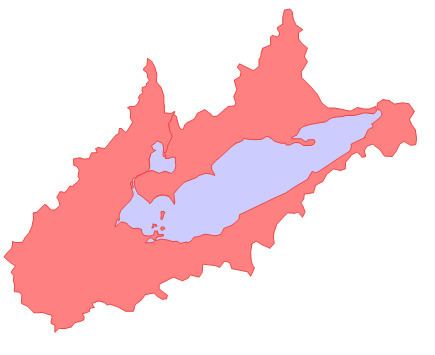Lake Erie Basin consists of Lake Erie and surrounding watersheds, which are typically named after the river, creek, or stream that provides drainage into the lake. The watersheds are located in the states of Indiana, Michigan, New York, Ohio, and Pennsylvania in the United States, and in the Province of Ontario in Canada. The basin is part of the Great Lakes Basin and Saint Lawrence River Watershed, which feeds into the Atlantic Ocean. 80% of the lake's water flows in from the Detroit River, with only 9% coming from all of the remaining watersheds combined. (The remainder (11%) is derived from direct precipitation into the lake.) A littoral zone serves as the interface between land and lake, being that portion of the basin where the lake is less than 15 feet (4.6 m) in depth.
The Lake Erie Basin was formed at the end of the Wisconsin glaciation. The basin was part of Glacial Lake Maumee until an eastern drainage opened at Niagara, at which point the Maumee River Watershed reversed its flow eastward. The Great Black Swamp is thought to be a remnant of the glacial lake.
Maumee Watershed (Adams, Allen, DeKalb, Noble, Steuben, and Wells counties) (see Ohio)Maumee RiverSt. Joseph RiverCedar Creek (Indiana)St. Mary's RiverMichigan's drainage basin consists of 5,808 square miles (15,040 km2).
Belle Watershed (Lapeer, Macomb, Oakland, and St. Clair counties)Belle RiverBlack WatershedBlack RiverClinton Watershed (Lapeer, Macomb, Oakland, and St. Clair counties)Clinton RiverDetroit Watershed (see also Ontario)Detroit RiverEcorse RiverRiver RougeHuron Watershed (Livingston, Monroe, Oakland, Washtenaw, and Wayne counties)Huron RiverPortage RiverPine WatershedPine RiverRaisin WatershedRiver RaisinMaumee Watershed (see Ohio)Tiffin River becomes Bean Creek in northern Ohio and MichiganNew York's drainage basin covers 2,300 square miles (6,000 km2).
Buffalo River Watershed (Erie, Genesse, and Wyoming counties)Buffalo Creek, Little Buffalo Creek, and Buffalo RiverCayuga CreekCazenovia CreekHunter CreekCattaraugus Creek Watershed (Cattaraugus, Chautauqua, Erie, and Wyoming counties)Cattaraugus CreekChautauqua Creek - Lake Erie Watershed (Chautauqua County) (see also Pennsylvania)Beaver CreekChautauqua CreekCrooked BrookHyde CreekScott CreekSilver CreekTwentymile CreekWalnut CreekAshtabula-Chagrin Watershed (Ashtabula, Cuyahoga, Geauga, Lake, and Portage counties) (see also Pennsylvania)Ashtabula RiverChagrin RiverAuglaize Watershed (Allen, Auglaize, Defiance, Mercer, Paulding, Putnam, and Van Wert counties)Auglaize RiverOttawa RiverBlack-Rocky Watershed (Ashland, Cuyahoga, Huron, Lorain, and Medina counties)Black RiverRocky RiverBlanchard Watershed (Allen, Hancock, Hardin, Putnam, and Wyandot counties)Blanchard RiverCedar-Portage Watershed (Hancock, Lucas, Ottawa, Sandusky, and Wood counties)Cedar CreekCrane CreekPacker CreekPortage RiverRusha CreekToussaint RiverTurtle CreekChautauqua-Conneaut Watershed (Ashtabula County) (see also Pennsylvania)Conneaut CreekCuyahoga Watershed (Cuyahoga, Geauga, Portage, and Summit counties)Cuyahoga RiverGrand Watershed (Ashtabula, Geauga, Lake, Portage, and Trumbull counties)Grand RiverHuron-Vermilion Watershed (Ashland, Crawford, Erie, Huron, Lorain, Richland, and Seneca counties)Huron RiverVermilion RiverMaumee Watershed (Defiance, Fulton, Hancock, Henry, Lucas, Putnam, Williams, and Wood counties) (see Michigan)Bad CreekBeaver CreekBrush CreekMaumee RiverSwan CreekTenmile CreekTiffin River becomes Bean Creek in northern Ohio and MichiganTurkeyfoot CreekOttawa-Stony Watershed (Fulton and Lucas counties) (see also Michigan)Ottawa RiverSandusky Watershed (Crawford, Erie, Hardin, Huron, Marion, Ottawa, Richland, Sandusky, Seneca, and Wyandot counties)Sandusky RiverAshtabula-Chagrin Watershed (Erie County) (see also Ohio)Ashtabula RiverChautauqua-Conneaut Watershed (Crawford and Erie counties) (see also Ohio)Conneaut CreekTurkey CreekLake Erie Watershed (Crawford and Erie counties)Detroit River Watershed (see also Michigan)Avon RiverDetroit RiverLake St. ClairSt. Clair RiverSydenham RiverThames RiverGrand River Watershed is the largest drainage in southern Ontario at 2,600 sq mi (7,000 km²)Grand RiverConestogo RiverEramosa RiverNith RiverSpeed RiverLynn River WatershedLynn RiverAgricultural, industrial, and residential land use are the primary nonpoint sources of pollution in the Lake Erie Basin. National and state environmental agencies, as well as interstate and binational cooperative efforts, focus on water quality, especially since the freshwater lake is used extensively for drinking water, recreation, and the fishing industry. Habitat and flow alteration cause siltation and sedimentation issues which can require dredging. Fertilizer runoff from farms and residences and unplanned releases from sewage treatment plants promote eutrophication through nutrient and organic enrichment, bacterial contamination, and the appearance of ammonium hydroxide. Industrial land use adds metals that flow into the basin and cause sediment contamination.

